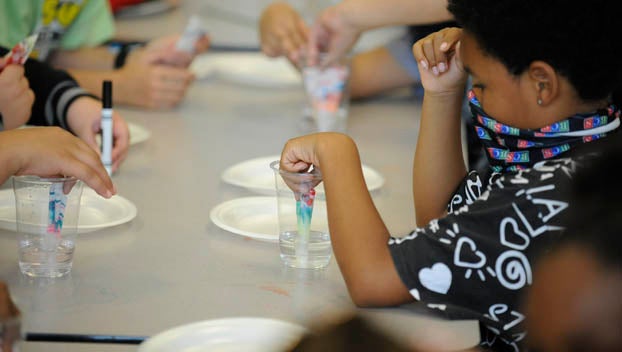COVID-19 transmission within NC schools is minimal, report says
Published 8:00 pm Wednesday, June 30, 2021

- John Small Elementary School students participate in the “capillary flowers” activity during Science Day earlier this year. (Brandon Tester / Washington Daily News)
|
Getting your Trinity Audio player ready...
|
A report published by the ABC Science Collaborative on Wednesday shows that North Carolina Schools did an “outstanding job” preventing the spread of COVID-19 within their facilities, and also states that mask-wearing is an “effective strategy” to prevent in-school COVID-19 transmission.
The Duke University School of Medicine and the Duke Clinical Research Institute created the ABC Collaborative in order to study and interpret the affects COVID-19 has had on schooling.
“North Carolina is charting the path forward for our nation, showing that schools can safely resume full in-person instruction while mitigating COVID-19 transmission,” said Dr. Danny Benjamin, co-chair of the ABC Science Collaborative. “These data should help school leaders chart a safe course to resume in-person instruction in the year ahead. In-person schooling offers more than an education – it offers a safe place for students to learn, live, and grow, and it is critical to the health of our nation’s children.”
The report features data from 100 school districts and 14 charter schools that operated under Plan A from March 2021 through June.
The report shows that of 864,515 students and 160,549 school staff members analyzed in that time frame, 308 students and 55 staff members acquired COVID via in-school transmission. About 95% of the 7,953 students and staff members who tested positive for COVID-19 acquired the virus from the community.
“Current quarantine guidelines have resulted in more than 40,000 students and staff being quarantined,” the report reads. “Thus, over 100 people were quarantined for every within-school infection. Due to the low transmission rate (an estimated secondary attack rate of 1%), and in order to promote in-person education, the State should consider eliminating quarantine for those appropriately masked or vaccinated.”
Other points mentioned in the report include:
- Plan A (full in-person instruction, as opposed to a hybrid or remote-only model) is appropriate for all grades and schools when masks are being worn.
- Full-capacity bus transportation is also appropriate with up to three masked students per seat. The ABC Collaborative data shows no difference in secondary transmission rate between schools that limited seating to one, two or three students per seat.
- Students could safely participate in athletics over the past year, but those activities present a “higher secondary attack rate than the within-classroom environment.”
The ABC Science Collaborative noted that the data presented in the report should encourage state officials to update the StrongSchools N.C. Public Health Toolkit, which lists the health practices and protocols schools need to follow in order to stop the spread of COVID-19.
“I first want to commend our districts, school leaders, and teachers for being so thorough in their planning and preparation to reduce within-school transmission of COVID,” said State Superintendent of Public Instruction Catherine Truitt. “It’s clear that schools could operate within Plan A in a safe and healthy way, while providing important face-to-face instruction for students. Seeing how successful North Carolina schools were in limiting transmission at a time when vaccination rates were relatively low gives me great optimism for the fall.
“Knowing that school districts are entering the new school year with higher vaccination rates for adults gives me hope that we will see mask mandates removed for K-12 students in the fall,” Truitt added. “As a proponent for local control, I believe this should be a local decision – one made by school boards in tandem with parents, based on what’s best for their student population.”





